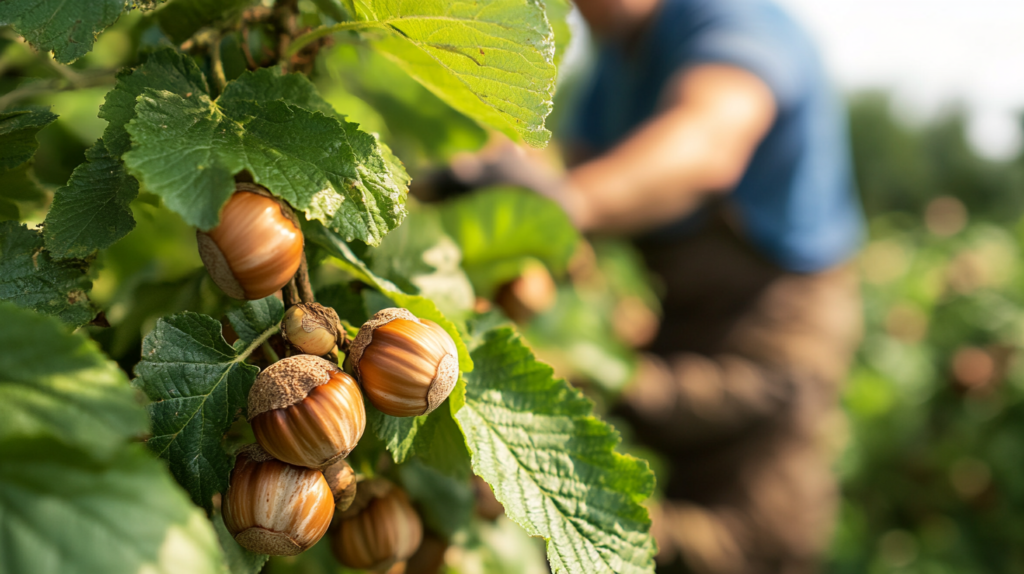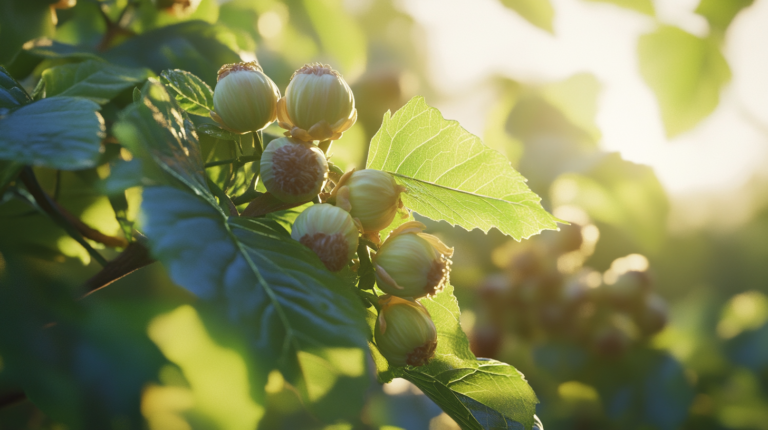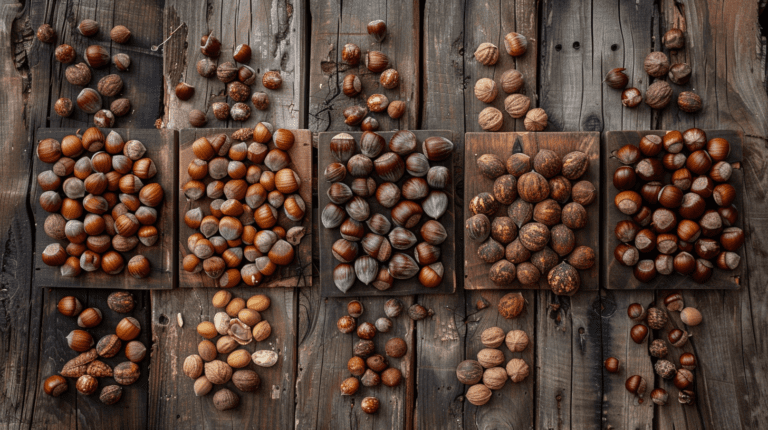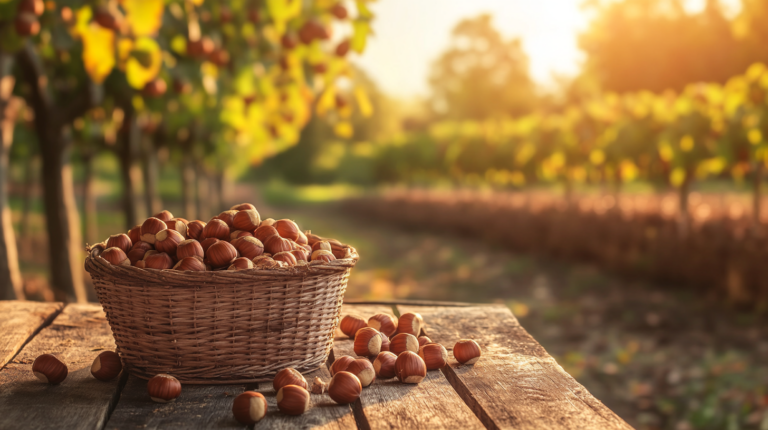Top Hazelnut Varieties for Organic Farming: Best Choices for High Yield and Sustainability
Hazelnuts are an increasingly popular crop for organic farming due to their low maintenance requirements, environmental benefits, and growing market demand. Selecting the right hazelnut varieties is crucial for successful organic cultivation. This comprehensive guide will explore some of the best hazelnut cultivars suitable for organic farming, their characteristics, and considerations for choosing the right varieties for your specific needs.
Disease Resistance
One of the most important factors in selecting hazelnut varieties for organic farming is disease resistance, particularly to Eastern Filbert Blight (EFB), a fungal disease that can devastate hazelnut orchards.

EFB-Resistant Varieties
Several hazelnut varieties have been developed with high resistance to EFB, making them ideal choices for organic farming:
Jefferson: Released by Oregon State University in 2009, Jefferson combines very high resistance to EFB with large nut size, good kernel quality, and high yields[5]. This variety has become popular among organic growers due to its disease resistance and overall performance.
Yamhill: Another introduction from Oregon State University, Yamhill features total resistance to EFB along with an attractive, compact growth habit and good crops of large, delicious nuts[5]. Its high productivity has made it a favorite among commercial growers, including those practicing organic methods.
McDonald: Named after Peter McDonald, a renowned grower from Wilsonville, Oregon, the McDonald variety is very disease resistant and aimed at the kernel market[5]. It fills nearly 51% of its shell compared to the traditional Barcelona variety at 42%, making it an efficient producer for organic farmers.
York: This variety not only produces delicious nuts but also shows resistance to EFB, bud mite, and has a low incidence of kernel mold[5]. These qualities make it an excellent choice for organic cultivation where pest and disease management options are limited.
Yield and Nut Quality
While disease resistance is crucial, organic farmers must also consider yield potential and nut quality when selecting hazelnut varieties.
Wepster: Developed to supply the chocolate and baking industry, Wepster produces kernels ranging from 11-13 millimeters, with the kernel weighing 47% of total weight[5]. Its high resistance to EFB and natural growth habit that requires little training make it an ideal choice for organic orchards.
Sacajawea: Introduced by Oregon State University, Sacajawea bears abundant crops of exceptionally flavorful nuts similar to prized Italian varieties[5]. While it has performed well in Oregon trials, it is somewhat less resistant to EFB than other varieties, so it may require more careful management in organic systems.
Eta: Developed primarily as a pollinator to cover the late flowering periods of other varieties such as Jefferson and Yamhill, Eta ensures maximum potential yield for each tree in the orchard[5]. This makes it a valuable addition to organic hazelnut plantings, where maximizing natural pollination is essential.
Environmental Adaptability
Organic farming often involves working with diverse environmental conditions, so selecting hazelnut varieties that can thrive in your specific climate and soil type is crucial.
Dutch Varieties for Organic Cultivation
In the Netherlands, researchers have developed hazelnut cultivars specifically suited for organic cultivation in their climate:
Emoa 1, Emoa 2, and Emoa 3: These cultivars have excellent yield potentials and good quality characteristics, including size, shape, taste, and ease of pellicle removal[1]. Their low susceptibility to disease makes them particularly suitable for organic cultivation in regions with similar climates to the Netherlands.
Intercropping Potential
Organic farming often emphasizes biodiversity and efficient land use. Some hazelnut varieties are well-suited for intercropping systems, which can enhance overall farm productivity and sustainability.
In the Netherlands, experiments have been conducted with intercropping hazelnuts alongside walnuts (Juglans regia L.) and Sea Buckthorn (Hippophaë rhamnoides L.)[1]. While specific variety recommendations for intercropping are not provided, this practice demonstrates the potential for hazelnuts in diverse organic farming systems.
Considerations for Organic Hazelnut Farming
When selecting hazelnut varieties for organic farming, consider the following factors:
1. Climate Suitability
Choose varieties that are well-adapted to your local climate, including factors such as winter hardiness, heat tolerance, and chilling requirements.
2. Soil Conditions
Hazelnuts generally prefer well-drained soils with a pH between 6.0 and 7.5. Some varieties may be more tolerant of less-than-ideal soil conditions, which can be beneficial in organic systems where soil amendments may be limited.
3. Pollination Requirements
Most hazelnut varieties require cross-pollination for optimal nut production. When planning your orchard, include compatible pollinizer varieties that flower at the same time as your main crop varieties. For example, York is a great pollinizer for most other hazelnut cultivars due to its relatively long period of pollen shed during mid-season flowering[5].
4. Harvest Timing
Consider selecting varieties with different maturation times to spread out the harvest period, which can be especially helpful for small-scale organic operations with limited labor resources.
5. Market Demand
Research the market demand for different types of hazelnuts in your area. Some varieties may be better suited for fresh eating, while others are preferred for processing or specific culinary applications.
Environmental Benefits of Organic Hazelnut Farming
Choosing to grow hazelnuts organically not only produces high-quality nuts but also offers significant environmental benefits:
Carbon Sequestration
Hazelnut trees capture more carbon than they release during production, making orchards effective carbon sinks[3]. This characteristic can help combat global climate change and may provide additional value through carbon credit programs.
Water Conservation
As perennial crops, hazelnut trees develop extensive root systems that can access water deep in the soil, reducing the need for irrigation after the establishment period[3]. This makes hazelnuts a more sustainable crop choice in regions facing water scarcity.
Soil Health
Organic hazelnut orchards can improve soil health over time. The trees’ extensive root systems and leaf litter contribute to building organic matter in the soil, enhancing its structure and fertility[2].
Biodiversity Support
Organic hazelnut orchards can provide habitat for beneficial insects and wildlife, contributing to overall ecosystem health and natural pest control.
Conclusion
Selecting the right hazelnut varieties is crucial for successful organic farming. Disease-resistant cultivars like Jefferson, Yamhill, and McDonald offer excellent potential for organic growers, while varieties like Wepster and Sacajawea provide high-quality nuts for different market segments. Consider your specific climate, soil conditions, and market demands when choosing varieties for your organic hazelnut orchard.
By incorporating a mix of compatible varieties, organic farmers can create resilient, productive orchards that not only yield delicious nuts but also contribute to environmental sustainability. As the demand for organic hazelnuts continues to grow, farmers who select the right varieties and implement sound organic practices will be well-positioned to meet this market need while supporting ecological health.
Sources:
[1] https://www.ishs.org/ishs-article/686_9
[2] https://www.arborday.org/programs/hazelnuts/consortium/agriculture.cfm
[3] https://www.uoguelph.ca/oac/news/ontario-hazelnuts-helpful-hand-environment
[4] https://www.orangepippintrees.co.uk/trees/nut-trees
[5] https://www.creeksidevalleyfarms.com/copy-of-hazelnuts
[6] https://fafard.com/hazelnuts-for-edible-landscaping/
[7] https://www.hazelnutnurseries.co.nz/growing
[8] https://www.ishs.org/ishs-article/1226_66






